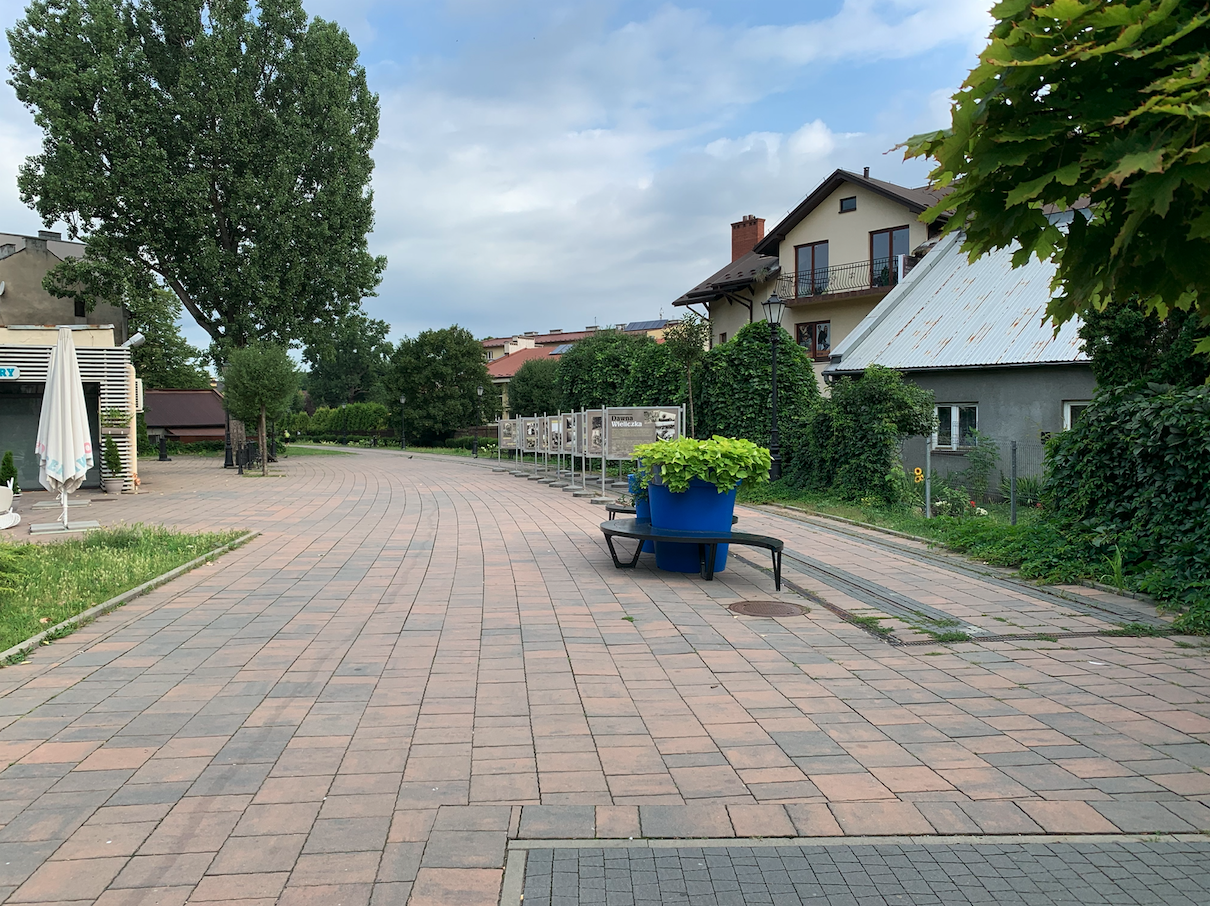Wieliczka 2022-08-04
Former passenger stop Wieliczka Rynek.
Geographic coordinates: 49.985N 20.060E. Elevation 242 m.
Currently (2022) there are three railway stations (passenger stops) in Wieliczka: Wieliczka – Rynek – Kopalnia (terminal stop), Wieliczka Park and Wieliczka Bogucice. There used to be a terminal stop Wieliczka Rynek, which is what this section is about.
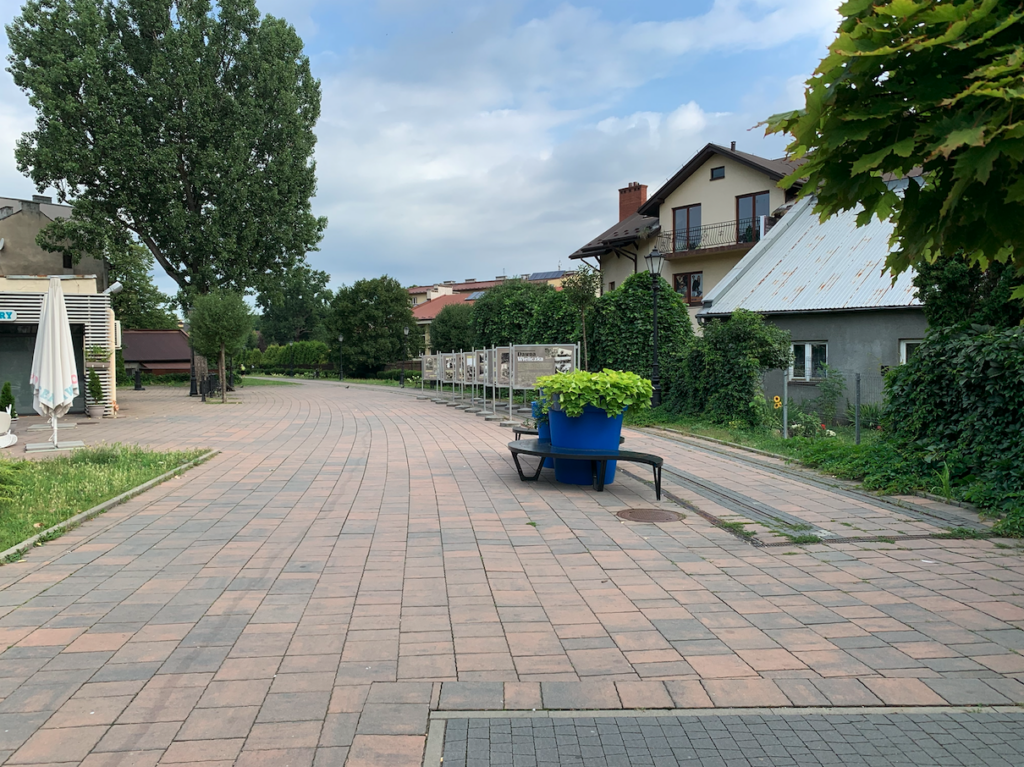
Photo description: The railway tracks have been left in the promenade. The visible boards show photos of the old Wieliczka. On the left side, a fragment of the station building from 1960 is visible.
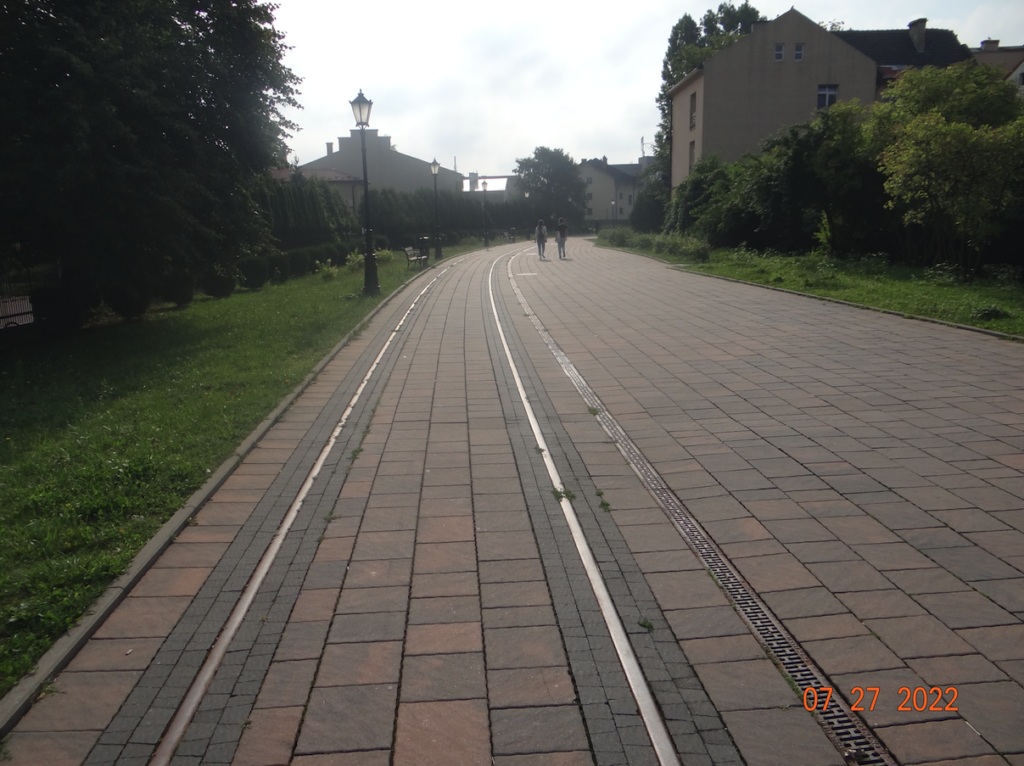
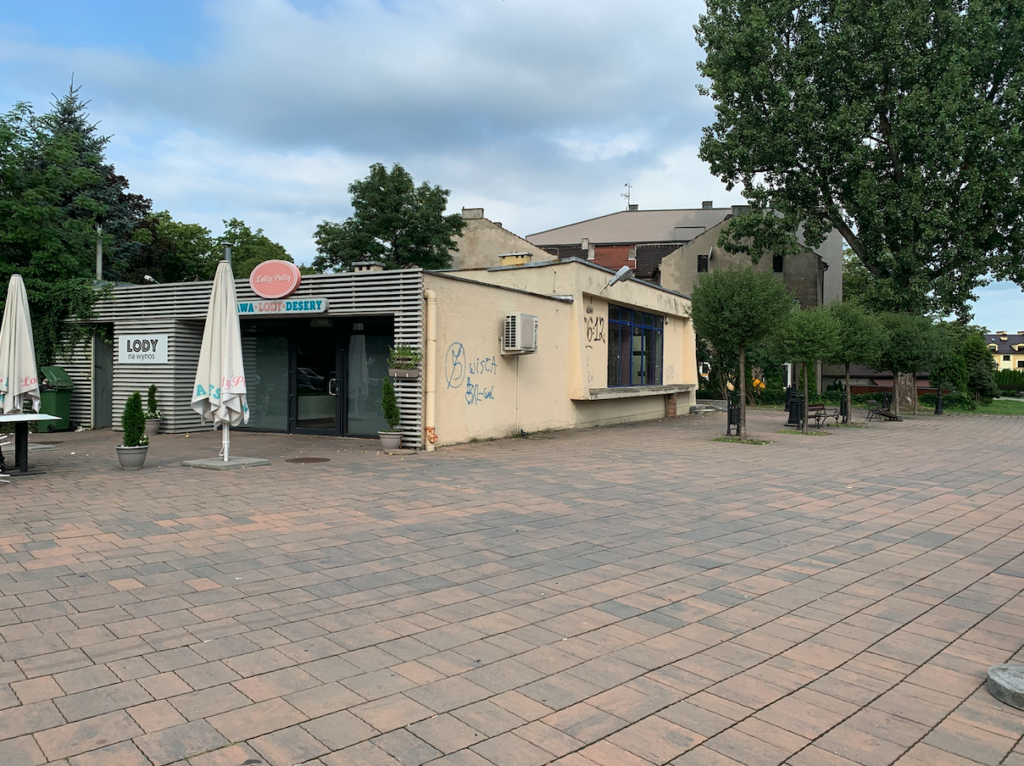
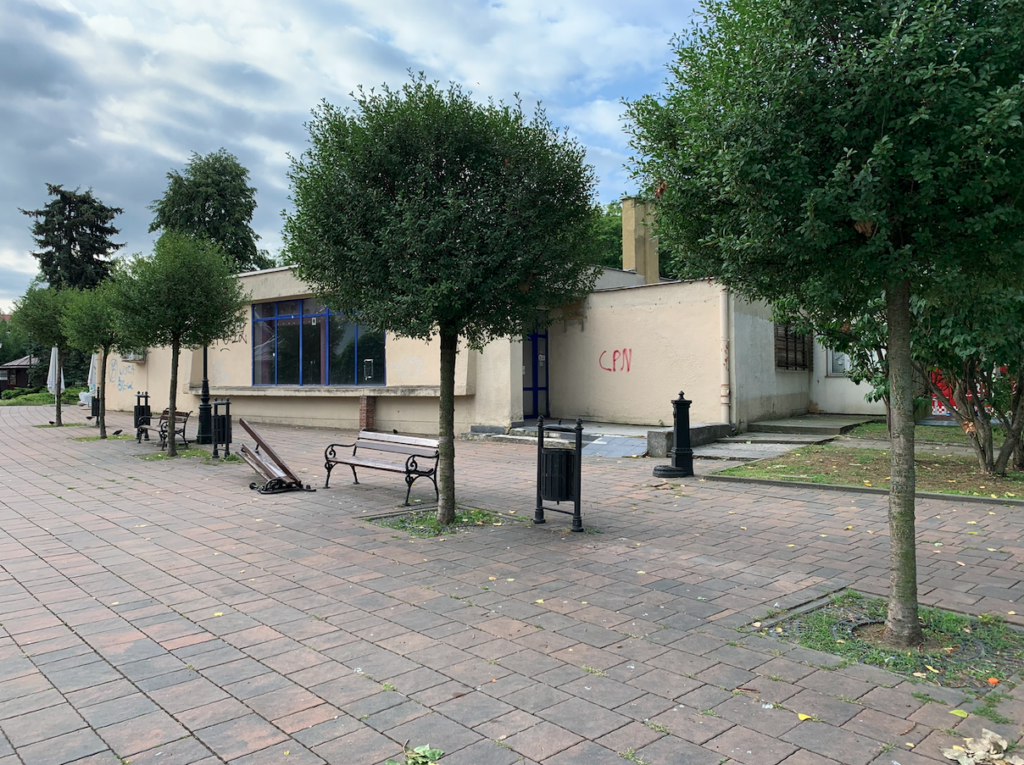
Railway route to Wieliczka.
But for order. The railway line to the Wieliczka salt mine was planned in 1855. Therefore, in 1856, the Kraków Bieżanów railway station was built on the Kraków – Tarnów railway route. In 1857, the Kraków Bieżanów – Salt Mine railway line was launched. At the same time, a railway station was built for the operating yeast factory. The line to Wieliczka was launched on January 26, 1857. The line belonged to the Austrian State Railways. Poland was then under partition.
The Wieliczka station was located next to the current Hotel Turówka. Originally, the facility was part of the saltworks. The construction of the new saltworks was carried out in the period 1812 – 1813, under the direction of the saltworks master Alojzy Hrdina, who came from Ebensee. The building was erected on land belonging to the city, on the area of a medieval farm called “TUR”. Hence the name of the building, Turówka. Ultimately, the building did not serve as a salt evaporator, because the Great World War broke out. The army was stationed in the building, and then it was turned into a warehouse. After 1857, after the construction of the railway line to Wieliczka, a railway siding was built to the building, which ended with a revolving switch. This allowed the carriage to be parked directly under the warehouse door, from the west side. More warehouses were built nearby. In the period 1920-1990, the entire upper floor of the building was designated for apartments for employees of the Wieliczka halls. In 1988, a staff hotel was established here, and in 2006, the Turówka Hotel.
In its heyday, Wieliczka Station had five tracks. A station was built on it, which still exists today, and the station is called Wieliczka Park. Rail traffic systematically increased. The trains ended and started at the current Wieliczka Park station.
The trains were connected by passenger and freight cars. Initially, only one pair of trains ran. From 1893, a second pair of trains was launched. The third pair of trains appeared after the construction of a connecting line towards Tarnów, at the Kraków Bieżanów station. This connecting line allowed trains to run directly from Wieliczka to Tarnów. Currently, this connecting line no longer exists.
In Austrian times, the authorities were only interested in the largest possible extraction of salt and its transport to Vienna. That is why the town of Wieliczka looked very poor. Most of the houses were made of wood. Only after Poland regained independence did the situation begin to improve.
In 1861, a railway siding was built in Wieliczka leading to the area of the Regis shaft, which was then called the Emperor Franz Joseph I shaft. At the end of the siding, a small station and warehouses were built, where the Salt Graduation Tower is now. The first salt wagons left this station on October 14, 1861. The wagons were pulled by horse-drawn carriages. In the following years, railway sidings were built to: Saint Kinga Shafts (then Empress Elizabeth), Tadeusz Kościuszko Shafts (then Emperor Joseph II). From 1889, the salt wagons were pulled by steam locomotives.
In 1927, the Wieliczka route was extended to the Wieliczka Rynek terminus. Passenger trains with tourists and residents arrived here. The station was serviced by a motor wagon, which made it easier to change direction. There was no turntable or second track at Wieliczka Rynek station.
The German occupation once again degraded the PKP company, and its expansion after World War II was expensive and time-consuming. In 1948, the line had No. 139, and in 1988, No. 121. Currently, it has No. 109.
In 1960, the line to Wieliczka was electrified, which was a great success. Thanks to this, capacious and comfortable EZT trains were sent to the line, which always ended their run at Wieliczka Rynek station. The first electric ETZ train set left the line on May 29, 1960. In 1965, 18-20 pairs of trains were already running to Wieliczka. The trains started their run at Kraków Główny station. Line No. 109 to Wieliczka was intensively used until the end of the 1980s. It carried freight trains carrying salt and bricks, as well as passenger trains, usually EN57. Freight trains in the other direction carried goods such as coal or wood, necessary for the mine’s operation.
In 1992, a major failure occurred in the Wieliczka Mine. It consisted of a leak of huge amounts of water, which threatened to flood the entire mine. However, this was not allowed to happen. Modern and efficient pumps resistant to salt water were installed and the leak was stopped. This leak caused damage to the tracks and trains had to end their runs at Wieliczka station (Wieliczka Park).
In the following years, salt mining in Wieliczka was completed and freight trains stopped running. Passenger traffic was taken over by private carriers, transporting passengers in buses. There were proposals to liquidate line No. 109. In addition, mining damage affected the damage to the tracks. The speed of EZT trains was limited. With the end of salt mining in Wieliczka, salt is no longer mined, but the brine extracted to the surface is sent to saltworks, where the salt is recovered.
In 2000, as a result of cuts in rail transport, all passenger connections from Krakow to Wieliczka were suspended. Fortunately, in 2001, rail traffic was restored, mainly due to the intervention of the Wieliczka local government. At that time, EZTs were in operation, such as railbuses of the EN81, EN57, and EN71 series.
Modernization of Railway Line No. 109.
On April 4, 2011, PKP Polskie Linie Kolejowe signed a contract with the consortium of Eurovia Polska and Eurovia CS for the modernization of Line No. 109. The works included the complete replacement of the track, the traction network, the installation of new SRK devices, the creation of comprehensive railway information and the construction of new platforms at all passenger stops. A new stop Wieliczka Bogucice was built. The previous Wieliczka station was renamed Wieliczka Park. A parking lot for P&R passenger cars was built at this station. The renovation of Line No. 109 included: the construction of new higher platforms, a new track bed and new tracks. Prestressed concrete sleepers were laid under the rails, and in many places metal sleepers of the “Y” type. The entire electric traction was replaced: poles and wires. A new traffic control system was installed. In Wieliczka, the total length of the line was shortened by approximately 260 m. The renovation was completed in 2012.
Due to the fact that the line is single-track, it is not possible to change the front of the train at the final stop Wieliczka Rynek-Kopalnia. The front of the train can be changed at the Wieliczka Park station. The line is equipped with a traction network that is adapted to a maximum speed of 110 km/h. SHP devices have been installed on the line. The maximum design speed of the route is 80 km/h. The line is adapted to a train speed of 60-70 km/h. Currently, line No. 109 is 5.419 km long. The line is planned to be equipped with devices for lubricating the sides of the rail head and wheel flanges.
The first scheduled train on the modernized route ran in August 2012. Such a quick implementation of the task was possible due to the complete suspension of rail traffic. Currently (2022) works are underway at the Kraków Bieżanów station and the track system connecting the routes is being rebuilt.
Wieliczka Rynek passenger stop.
The Wieliczka Rynek passenger stop operated from 1927 to 2010. The platform was located between Adama Mickiewicza Street and the intersection of Powstania Warszawskiego and Księdza Zygmunta Goliana streets. The platform was of a low type with an asphalt surface. The platform height was about 0.40 m above the railhead. There were three roofs on the platform with simple benches. There was lighting in the form of street lamps. The stopper was located at the very intersection of Powstania Warszawskiego and Księdza Zygmunta Goliana streets. But there was a period, even before the electrification of the line, when the railway tracks crossed the intersection and the current “Plac Kościuszki” park and ended next to the building of the “Szyb Regis” mine. A fragment of the railway track has been preserved in the pavement next to the shaft.
The first station building was opened in 1927 and was an adaptation of a small barrack. A new station was built in 1960, during the electrification of the route. The station was in the form of a pavilion with a waiting room and a ticket office. Currently (2022) the building still exists, but it only serves commercial and catering functions.
Wieliczka Rynek station was closed after a failure in the “Wieliczka” salt mine in 1992. A huge leak occurred in the mine and the mine was at risk of flooding. Fortunately, after many months the situation was brought under control. Trains ran only to the previous station, which was then called Wieliczka, and is now Wieliczka Park. The track was at risk of destruction due to a failure in the mine. After a few years, traffic to Wieliczka Rynek station was restored, but the trains ran very slowly.
In the period 2005 – 2009 Retro trains with historic electric locomotives, such as the EP03, sometimes ran to Wieliczka Rynek station.
Currently (2022) there is no platform and typical track at the former Wieliczka Rynek station. The reconstruction was carried out in 2014. There is a promenade in this place, which is part of the “Salt Route”. The rails of the former track have been left in a very nice sidewalk. In the period 2020 – 2022, an exhibition with photos from the old Wieliczka was placed on the route. This route can be used to go to the next station Wieliczka Park.
Written by Karol Placha Hetman
